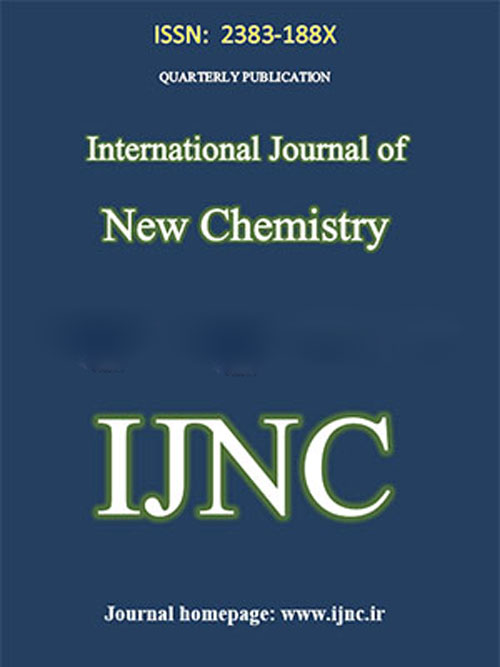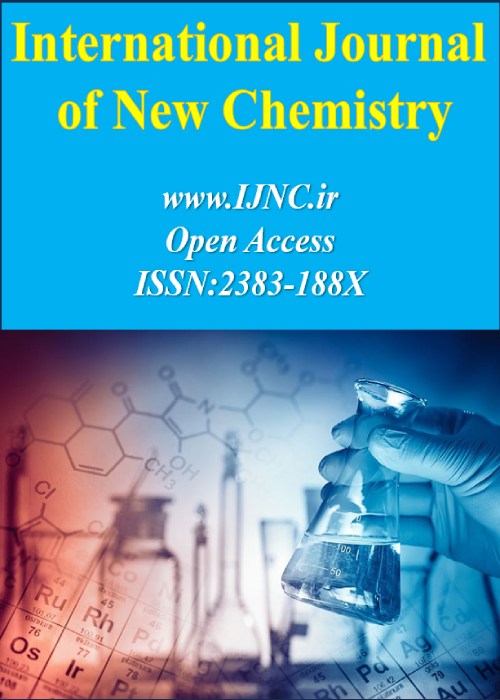فهرست مطالب

International Journal of new Chemistry
Volume:1 Issue: 3, Autumn 2014
- تاریخ انتشار: 1393/09/30
- تعداد عناوین: 5
-
صفحات 115-125
-
صفحات 134-144
-
Pages 97-107Electrical sensitivity of a boron nitride nanotube (BNNT) was examined toward (C3H4) molecule by using density functional theory (DFT) calculations at the B3LYP/6-31G (d) level, and it was found that the adsorption energy (Ead) of methylacetylene (C3H4) the pristine nanotubes is a bout -1.78kcal/mol. But when nanotube have been doped with Si and Al atomes, the adsorption energy of methylacetylene molecule was increased. Calculation showed that when the nanotube is doping by Al, the adsorption energy is about -22.73kcal/mol and also the amount of HOMO/LUMO energy gap (Eg) will reduce significantly. Boron nitride nanotube is a suitable adsorbent for methylacetylene and can be use in separation processes methylacetylene. It is seem that nanotube (BNNT) is a suitable semiconductor after doping, and the doped BNNT in the presence of methylacetylene an electrical signal is generating directly and therefore can potentially be used for methylacetylene sensors.Keywords: Nanotube, DFT, Methylacetylene, Sensor
-
Pages 108-114A new one-pot, efficient three-component condensation of dimedone, urazole and aromatic aldehydes in the presence of silica supported sodium hydrogen sulfate as an effective heterogeneous catalyst for the synthesis of novel Triazolo[1,2-a]indazole-1,3,8-trione derivatives under solvent-free conditions is described.Keywords: Solvent, free, dimedone, Urazole, Triazoloindazole
-
Pages 115-125Electrical sensitivity of a boron nitride nanotube (BNNT) was examined toward hydroquinone (C6H4(OH)2) molecule by using density functional theory (DFT) calculations at the B3LYP/6-31G(d) level, and it was found that the adsorption energy (Ead) of hydroquinone on the pristine nanotube is a bout -7.77kcal/mol. But when nanotubes have been doped with Si and Al atomes, the adsorption energy of hydroquinone molecule was increased. Calculation showed that when the nanotube is doping by Al, the adsorption energy is about -19.70kcal/mol and also the amount of HOMO/LUMO energy gap (Eg) will reduce significantly. Boron nitride nanotube is a suitable adsorbent for hydroquinone and can be use in separation processes hydroquinone. It is seem that nanotube (BNNT) is a suitable semiconductor after doping, and the doped BNNT in the presence of hydroquinone an electrical signal is generating directly and therefore can potentially be used for hydroquinone sensors.Keywords: Sensor, Nanotube, DFT, Hydroquinone
-
Pages 126-133The complexation of zinc (II) with dopamine has been investigated by spectrophotometric measurements in mixed solvent system at an ionic strength of 0.2 mol*dm-3 sodium chloride, employed (25± 0.1° C) at pH ranges of ~6 to ~7 with a high ratio of ligand to metal.Keywords: Zinc (II), Catecholamine, Complexation, Mixed solvent
-
Pages 134-144Electrical sensitivity of a beryllium oxide nanotube (BeONT) was examined toward (C4H5N) molecule by using density functional theory (DFT) calculations at the B3LYP/6-31(d) level, and it was found that the adsorption energy (Ead) of pyrrole on the pristine nanotubes is a bout -48.58kcal/mol. But when nanotubes has been doped with S and P atomes , the adsorption energy changed. Calculation showed that when the nanotube is doping by P, the adsorption energy is about -29.04kcal/mol and also the amount of HOMO/LUMO energy gap (Eg) will reduce significantly. Beryllium oxide nanotube is not suitable adsorbent for pyrrole, but when the BeONT doped by P atom the amount of Eg was less than pristine BeONT and that is a suitable semiconductor.Keywords: Nanotube, DFT, Pyrrole, Sensor


